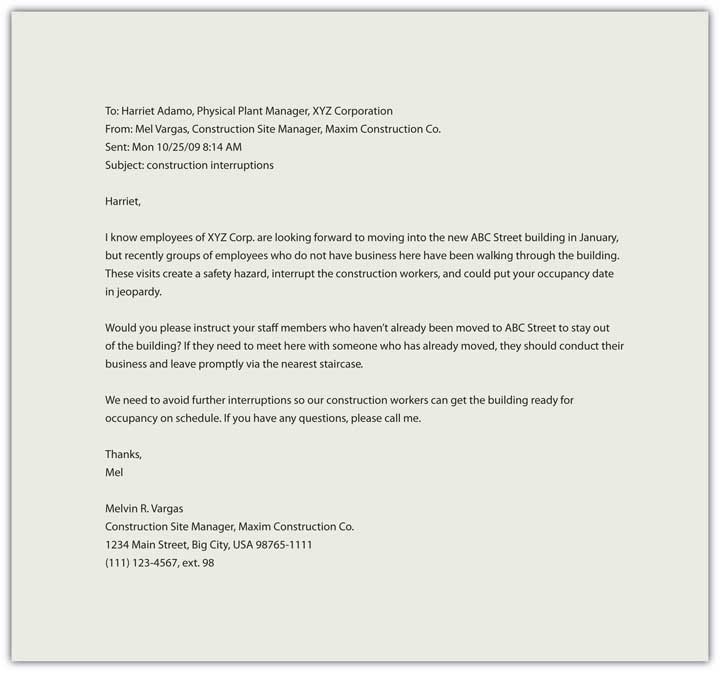4.3 Emails
Email is typically quite familiar to most students and workers. While it may be used like text messaging, or synchronous chatting, and it can be delivered to a cell phone, email remains an asynchronous communication tool. In business, email has largely replaced print hard copy letters for external (outside the company) correspondence, as well as taking the place of memos for internal (within the company) communication (Guffey, 2008). Email can be very useful for messages that have slightly more content than a text message, but it is still best used for fairly brief messages.
Many businesses use automated e-mails to acknowledge communications from the public or to remind associates that periodic reports or payments are due. You may also be assigned to “populate” a form email in which standard paragraphs are used, but you choose from a menu of sentences to make the wording suitable for a particular transaction.
Emails may be informal in personal contexts, but business communication requires attention to detail, awareness that your email reflects you and your company, and a professional tone so that it may be forwarded to any third party if needed. Email often serves to exchange information within organizations. Although email may have an informal feel, remember that when used for business, it needs to convey professionalism and respect. Never write or send anything that you wouldn’t want read in public or in front of your company president or CEO.
Tips for effective business emails
- Proper salutations should demonstrate respect and avoid mix-ups in case a message is accidentally sent to the wrong recipient. For example, use a salutation like “Dear Ms. X” (external) or “Hi Barry” (internal).
- Subject lines should be clear, brief, and specific. This helps the recipient understand the essence of the message. For example, “Proposal attached” or “Your question of 10/25.”
- Close with a signature. Identify yourself by creating a signature block that automatically contains your name and business contact information.
- Avoid abbreviations. An email is not a text message, and the audience may not find your wit cause to them to ROTFLOL (roll on the floor laughing out loud).
- Be brief. Omit unnecessary words.
- Use a good format. Include line breaks between sentences or divide your message into brief paragraphs for ease of reading. A good email should get to the point and conclude in three small paragraphs or less.
- Reread, revise, and review. Catch and correct spelling and grammar mistakes before you press “send.” It will take more time and effort to undo the problems caused by a hasty, poorly written email than to get it right the first time.
- Reply promptly. Watch out for an emotional response—never reply in anger—but make a habit of replying to all emails within 24 hours, even if only to say that you will provide the requested information in 48 or 72 hours.
- Use “Reply All” sparingly. Do not send your reply to everyone who received the initial email unless your message absolutely needs to be read by the entire group.
- Avoid using all caps. Capital letters are used on the internet to communicate emphatic emotion or yelling and are considered rude.
- Test links. If you include a link, test it to make sure it is complete.
- Announce email attachments in your message.
- Give feedback or follow up. If you don’t get a response in 24 hours, e-mail or call. Spam filters may have intercepted your message, so your recipient may never have received it.
Figure 4.3.1 provides an example of a business email.
Netiquette
We create personal pages, post messages, and interact via mediated technologies as a normal part of our lives, but how we conduct ourselves can leave a lasting image, literally. The photograph you posted on your Instagram page may have been seen by your potential employer or that nasty remark in a Facebook post may come back to haunt you later. Several years ago, when the internet was a new phenomenon, Virginia Shea laid out a series of ground rules for communication online that continue to serve us today.
Virginia Shea’s rules of netiquette
- Remember the human on the other side of the electronic communication.
- Adhere to the same standards of behaviour online that you follow in real life.
- Know where you are in cyberspace.
- Respect other people’s time and bandwidth.
- Share expert knowledge.
- Keep flame wars under control.
- Respect other people’s privacy.
- Don’t abuse your power.
- Be forgiving of other people’s mistakes (Shea, 1994).
Her rules speak for themselves and remind us that the golden rule (treat others as you would like to be treated) is relevant wherever there is human interaction. It is also important to remember to keep your public persona online as professional as possible and to familiarize yourself with the privacy settings of the social media platforms you use.
References
Guffey, M. (2008). Essentials of business communication (7th ed.). Mason, OH: Thomson/Wadsworth.
Shea, V. (1994). Netiquette. San Francisco, CA: Albion Books.
Attribution
This chapter contains material taken from Chapter 9.1 “Text, email, and netiquette” in Business Communication for Success and is used under a CC-BY-NC-SA 4.0 International license.


